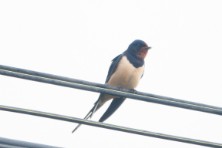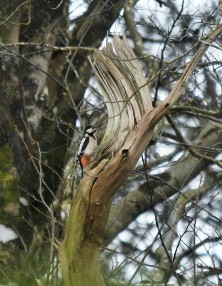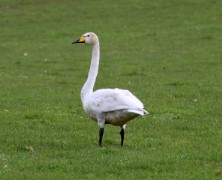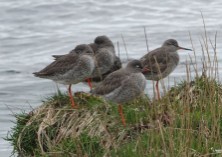April 2024
Bird Sightings



April is the month when spring migration gets underway, with arrivals and departures of birds, all seeking their best breeding territories. While there was a third less rain than March (the wettest month of the year) and the mean temperature was one degree warmer than March, it still felt like a wet, cold month. There was respite from the rain from 19th to 28th of the month but it was cold. The impact on migrating birds of the weather here and throughout their route is difficult to know, but even by the end of the month the bulk of the migrants had still to arrive. A number of observers felt there were fewer birds around than recent years. The impact on inclement weather on breeding birds remains to be seen but some initial nests of shore breeding birds were washed away and some Grey Heron chicks were blown out their nests in Lochranza on 9 April.
As reported at the end of March, the first Wheatear, Chiffchaff, and Willow Warbler had arrived. Here are April “firsts” with the 2023 arrival date in brackets for comparison: Sand Martin 1st (28 March), Manx Shearwater 1st (8th), White Wagtail 3rd (3rd), Sandwich Tern 3rd (3rd), House Martin 6th (11th), Swallow 7th (6th), Common Sandpiper 8th (17th), Cuckoo 17th (19th), Grasshopper Warbler 20th (22nd), Tree Pipit 20th (7 May), Whitethroat 21st (28th), Whinchat 21st (11 May), and Sedge Warbler 28th (28th) but these were just the pioneers the bulk would arrive throughout April and May.
In April some of our wintering birds were still around, including two Redwing at Auchencar on 2nd, six Purple Sandpiper on Silver Sands on 5th, forty-five Teal on Sliddery Shore on 9th, two Wigeon at Clauchlands on 17th, one Fieldfare on Corriecravie Moor on 23rd and one hundred Pink-footed Geese over Sliddery on 24th. In the Shiskine Valley the migratory Greylag Geese left by mid-April but the solitary Whooper Swan rescued on 31 December 2023 remains. Our naturalised Greylag Geese population that hang about Lamlash Bay were on nests on the Holy Isle by 24th.
April is an ideal time for watching migration. These are a few examples: ten Common Scoter in Whiting Bay on 1st; a Grey Plover on Silver Sands also on 1st ( features in a future “Banner” article); forty-five Turnstone at Machriewaterfoot on 3rd: fifty-five Meadow Pipit in Machrie on 4th; sixteen Redshank in Whiting Bay on 11th; a Redstart at Largybeg on 13th; seven White Wagtail at Porta Buidhe on 20th ; and eighty-nine Golden Plover by Lagg Distillery on 22nd. In addition, groups of migrating Whimbrel were reported including ten at Blackwaterfoot on 22nd, fifteen at Torrylinn on 23rd and twenty at Porta Buidhe on 29th. One of these Whimbrel, A2, had been ringed on a southern Arran shore in 2017. It will feature in a future “Banner” article as will Osprey with two records in April . Migration was also in evidence from the widespread reports received of Goldfinch and Siskin moving through people's gardens throughout the month. Tens of thousands of birds seem to be moving through the island at this time of year.
In April there were over one hundred and ten species recorded on Arran. One of these, Little Egret , again over-wintered on Arran. Last report received was two in Carlo on 19th. Here is a further small selection from this list: a Red Kite over Lagg on 1st, twenty Great Northern Diver in Blackwaterfoot on 2nd, four Goosander at Clauchlands on 12th, a White-tailed Eagle over Sliddery on 20th and seven Black-throated Diver in Cosyden on 30th.
From a birding point of view, May should be an equally interesting month with the bulk of our summer visitors arriving including more species like Garden Warbler, Lesser Whitethroat, Wood Warbler, Spotted Flycatcher, Arctic Tern and hopefully, even Corncrake and Nightjar. Please continue to keep me posted on all summer visitors in your area. Your ongoing support is much appreciated.
Finally, spring is a great time to be birding, as most birds are getting on with the business of breeding. The business of breeding involves attracting a mate by song, courtship display and ritual, defining a territory, nest building, and generally establishing relationships. Please take a moment to report any signs of breeding birds to me. Already there have been reports of Blue Tits nest building, Blackbirds carrying food, fledged Ravens, Sandwich Tern courting while migrating and Lapwing displaying in a small number of areas.
Please remember that under the Nature Conservation (Scotland) Act 2004 it is an offence to intentionally or recklessly damage or destroy the nest of any wild bird while it is being built or used. Take particular care on our shores and beaches and please keep your dogs on a lead at this time. They are a danger to all our ground nesting birds.


